A kid-friendly mobile app giving children the power to participate in research studies to improve their health won first place at the inaugural Ann Arbor Health Hackathon: Prototyping Disease Prevention, co-sponsored WDI.
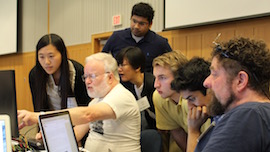
The round-the-clock event, held June 24-26 on the University of Michigan campus, drew 91 participants who formed 18 teams comprised of students, researchers, and professionals from the biomedical, engineering, IT, business, clinical, design, and public health sectors. Hackathon judges awarded prizes for first, second and third places, as well as a Cardiovascular Prize. Participants voted on a People’s Choice Prize. Teams were assisted by more than 40 mentors who wandered the room, listened to the groups and provided feedback.
The second-place team created a virtual reality app to help patients suffering from post-traumatic stress disorder, while the third-place team developed a personalized, real-time motion capture application to improve physical therapy. The Cardiovascular Prize went to a team that developed an easy-to-understand, paper-based test to signal onset of atherosclerosis – the buildup of fats, cholesterol and other substances on the artery walls. Finally, the People’s Choice Prize went to a team that worked to connect transportation and grocery stores to increase access to nutritious food.
All winners were given incubation space at Ann Arbor SPARK, the local economic development organization, to further develop their ideas. In addition, the top winners received partial scholarships from SPARK for its Entrepreneur Boot Camp and $500 from WDI to cover additional costs for the camp. Winners also were awarded customer discovery services from The SearchLite, an Ann Arbor company that helps entrepreneurs commercialize their invention or startup. There also were cash prizes.
“The hackathon achieved the two goals we set for it: develop some innovative solutions to real challenges in healthcare and bring together the Ann Arbor community,” said Brittany Johnson, a global health supply chain consultant and organizer of the event.
Another hackathon organizer, Diane Bouis, said it fostered medical innovation and the local medical startup ecosystem.
“We wanted to get the brightest people in the room and enable them to make incredible things happen,” said Bouis, director of innovation programs at The Inovo Group, a strategic innovation consultancy in Ann Arbor. “And I can truly say that we are humbled by what we saw.”
A networking event Friday evening kicked off the weekend, with the hackathon starting Saturday morning. Participants worked through the night until noon Sunday, then presented their projects to a panel of judges.
“The best part of this event was seeing all the brain power mesh in the room,” said WDI Healthcare Research Associate Beatrix Balogh, one of the event organizers.
“Seeing the results of ideas are great, but you see it in a completely different light when you spend the entire weekend watching people work together. They throw out ideas, find other folks who share those same interests to form a team, really hone in on how to best develop out that idea, and just take off.”
Balogh said another success was the diversity amongst the teams with participants coming from various fields of study and a good mix of students and professionals.
“The number one thing that made me so incredibly happy is that 50 percent of the A2 Health Hackers were women,” Balogh said. “I’ve been to so many hackathons where the majority of participants are guys, so it was such a relief to see so many women at our event.”
Neelima Ramaraju, director of global health initiatives at Ann Arbor’s LLamasoft, a supply chain design firm, and a hackathon organizer said the event’s energy was “electric, positive, and contagious.”
“We are excited to follow the winning teams and see the impact they will have on the world,” she said.
Round-the-clock hackathons are more commonly associated with software developers and computer programmers building new tech gadgets. But health-themed hackathons are increasing in popularity as those interested in the healthcare field explore new ways to innovate and create new technologies and processes.
“We received a lot of encouragement to make this an annual event, and the great energy from this weekend has motivated us to start planning for 2017,” Johnson said.
Partners for the event were The Inovo Group, HealthDesignBy.Us and Gamestart. In addition to WDI, other hackathon sponsors were: LLamasoft, SPARK, The SearchLite, U-M Institute for Healthcare Policy & Innovation, Oakland County Economic Development and Community Affairs, The SearchLite, Frankel Cardiovascular Center, St. Joseph Mercy Health System and Arboretum Ventures.
Registration is now open for the upcoming Ann Arbor Health Hackathon: Prototyping Disease Prevention. Click here to register and to find out more about the June 24-26 event, which is sponsored by several organizations including WDI.
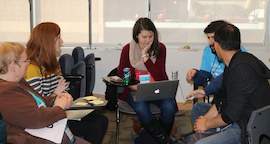
Round-the-clock hackathons, more commonly associated with software developers and computer programmers building new tech gadgets, have now moved into the global health realm. The Ann Arbor hackathon aims to harness the same spirit of energy, collaboration, and dedication to prevent the spread of disease, said WDI Healthcare Research Associate Beatrix Balogh, one of the event organizers.
Health-themed hackathons explore new ways to innovate and create new technologies and processes. In February, Balogh participated in a Boston hack where she and her team worked on a training/business model around self-screening for breast cancer in rural areas of Africa. She also spent time taking notes in preparation for the Ann Arbor event.
“We were able to talk to the organizers about things that worked well, things they struggled with,” said Balogh, who works in the market dynamics group of WDI’s Healthcare Research Initiative. “They had a lot of good insights.”
About a year ago, shortly before Balogh and Brittany Johnson, a global health supply chain consultant, attended a hackathon in Cleveland, they began kicking around the idea of bringing a health-themed hack to Ann Arbor. They reached out to Neelima Ramaraju, director of global health initiatives at Ann Arbor’s LLamasoft, a supply chain design firm, to gauge her interest.
“Between the resources, talent, and enthusiasm we have in this community, it seemed like a no-brainer,” Ramaraju said. “So far the community has been very receptive and supportive, validating our reasons for getting started.”
Ramaraju brought in friend Diane Bouis, director of innovation programs at The Inovo Group, a strategic innovation consultancy in Ann Arbor.
Together, the four women formed the nonprofit Ann Arbor Health Hack (A2H2 for short) and started making plans for a hackathon in Ann Arbor this summer.
The event will be held at Palmer Commons on the U-M campus. The organizers are hoping at attract 200-250 students, researchers, and professionals from the biomedical, engineering, IT, design, and public health sectors.
It will focus on disease prevention in developing countries as well as underserved areas of developed countries. Prevention includes creating information tools, enhancing education of patients and caretakers, policy and social engineering. It also includes products and services such as personal and surgical hygiene, family planning, wellness care, diagnostics, vaccines, and medication adherence.
A networking event Friday evening will kick off the weekend, with the hackathon starting Saturday morning. Participants will work through the night until noon Sunday, and present their projects to a panel of judges. The winners receive prize money and potentially a space to incubate their idea along with some seed funding.
In addition to WDI, the other sponsors are: The Inovo Group, LLamasoft, Ann Arbor SPARK, MakeHealth Fest, Gamestart, U-M Institute for Healthcare Policy & Innovation, Oakland County Economic Development and Community Affairs, The SearchLite, and Arboretum Ventures.
Ramaraju said events like hackathons make the global healthcare space more accessible.
“As a complex and highly-regulated field, the healthcare market requires deep domain knowledge to bring about change, making it difficult for a lay coder or maker to have a significant impact on their own,” she said. “A hackathon will bring together the medical, academic, entrepreneurial, and industry minds to generate novel ideas, and hopefully new products that lead to healthier lives worldwide.”
Organizers, who plan to make this an annual event, ask attendees to come with ideas, but not necessarily with a set team. As participants discuss their ideas during the pre-hack mixer on Friday night, organizers hope people will start to gravitate towards projects that appeal to them.
Hackathons are most successful when diverse teams form at the start of the event, Bouis said.
“Bringing together a diverse team of people from different areas can help find solutions that somebody who is a deep specialist would have never found by themselves,” she said. “You cannot do something radically new if you think along the same pathways with the same people you have already thought with and worked with in the past. Mix it up.”
Ramaraju said a hackathon “can energize the community, make people aware of the existing resources, and create collaboration opportunities that wouldn’t have otherwise existed.”
The event, Bouis said, enables people to do great things. It is a conduit for bringing the right people together.
“If something that changes the face of healthcare comes out of the hackathon, that will be immensely gratifying,” Bouis said. “Can I guarantee that there will be any to change the face of healthcare? No, I can’t promise. Is it possible? Yes, and that’s exciting.”
Image courtesy of Global Cancer Innovation Hack-a-thon.
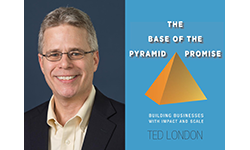
WDI Senior Research Fellow Ted London will be the featured guest for a May 17 webinar organized by Business Call to Action (BCtA) and the Practitioner Hub on Inclusive Business. Click here to register for the free webinar, which begins at 9 a.m. Eastern U.S.
London, who also leads the Institute’s Scaling Impact Initiative, will discuss his recently-released book, “The Base of the Pyramid Promise: Building Businesses with Impact and Scale.”
The webinar will be hosted Caroline Ashley, director of Ashley Insight and editor of Practitioner Hub. It will feature an interactive Q&A with the audience.
For more information:
At WDI’s Education Initiative, we are curious to learn about what schools and organizations are doing to promote educational innovation – especially with tools that could be used within emerging economies.This leads us to develop partnerships and explore models all over the world. Sometimes, however, pioneering work is happening just down the street. And so WDI’s Education team was privileged to recently visit the staff at the Division of Integrative Systems + Design (ISD) within the College of Engineering, University of Michigan.
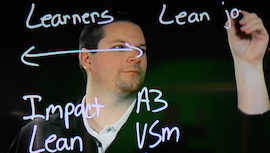 ISD’s mission is “dedicated to educating leaders who can think transformatively and create lasting value in the workplace and society.” It offers interdisciplinary technical graduate degrees, as well as professional certificates, short courses, and custom programs – bridging on-campus, distance, and online students, mostly in the College of Engineering. To accommodate students taking courses both online and face-to-face – sometimes with the same course serving both sets of students simultaneously – ISD has developed some first-rate tools. We learned about many of them from the ISD’s Instructional Support team:
ISD’s mission is “dedicated to educating leaders who can think transformatively and create lasting value in the workplace and society.” It offers interdisciplinary technical graduate degrees, as well as professional certificates, short courses, and custom programs – bridging on-campus, distance, and online students, mostly in the College of Engineering. To accommodate students taking courses both online and face-to-face – sometimes with the same course serving both sets of students simultaneously – ISD has developed some first-rate tools. We learned about many of them from the ISD’s Instructional Support team:
 The lightboard gives luminous new meaning to the “flipped classroom.” A lightboard is a glass screen through which professors are filmed lecturing in studio. Functioning as a transparent chalkboard, the instructor can write notes on the screen while facing the camera, which is then mirrored, becoming readable to the viewer. The instructor can, without interruption to face time, elaborate on and annotate charts, graphs, and slides in areas of the lightboard. The engagement between professor and students is unbroken by the professor turning around to write on a chalkboard, or by that recent classroom ailment of screen fatigue. Even more importantly, the professor and students are – symbolically and physically – engaging material created between them. The instructor remains the material’s facilitator, but not its sole mediator, standing between it and the students; rather, students and instructor are looking upon common material for the sake of shared learning.
The lightboard gives luminous new meaning to the “flipped classroom.” A lightboard is a glass screen through which professors are filmed lecturing in studio. Functioning as a transparent chalkboard, the instructor can write notes on the screen while facing the camera, which is then mirrored, becoming readable to the viewer. The instructor can, without interruption to face time, elaborate on and annotate charts, graphs, and slides in areas of the lightboard. The engagement between professor and students is unbroken by the professor turning around to write on a chalkboard, or by that recent classroom ailment of screen fatigue. Even more importantly, the professor and students are – symbolically and physically – engaging material created between them. The instructor remains the material’s facilitator, but not its sole mediator, standing between it and the students; rather, students and instructor are looking upon common material for the sake of shared learning.
The lightboard is primarily used for teaching the school’s online, largely global population of students.
_________
This is all very cool, but how does it connect to WDI Education’s work of advancing management education in emerging markets? And what, if any, are the upshots for our global partners? Permit me a few suggestions:
First, these innovations are mostly cost-effective and replicable. The lightboard took plenty of engineering savvy and passion, but not much money. The recording system in the classroom utilizes repurposed components. When paired with such tools, the professors’ content becomes a reusable asset. Using tech doesn’t have to mean loads of money or complex systems.
Second, ISD serves online and classroom-based students alike. As a result, their tools in design and function see beyond an either-or world of virtual or in-person; they try to create adaptive blended spaces in which interaction, even if through a screen, fosters more learning-centered, human interaction.
Finally, on this note, our tour demonstrated that ISD puts learning first. And this gets to the heart of why it is working well: ISD’s technical savvy and passion to create these tools is driven by pedagogy. As Roy Johnson, Senior eLearning Coordinator, says “Building relationships with and listening to faculty’s needs comes first.” This allows the team to respond to the needs of the faculty rather than foist pre-made resources upon them. The ISD team identifies with professors’ problems, taking an “assess needs first, recommend tools second” approach; of saying “We’re here to help their course,” and asking “What are you trying to do?” rather than “Here are these tools at your disposal,” says Johnson. Innovation, he says, often comes from a pain point. Sometimes this pain point drives the ISD team to further innovate. But sometimes they recognize solutions that are already there, and free of charge. For example, an instructor admitted to Johnson feeling overwhelmed with reviewing videos submitted by her 90 students. Jason Crandall, eLearning Instructional Designer, set up a Google+ Community for the students to upload directly, effectively adding a peer-review component to the assignment, thereby enhancing learning while aiding the professor’s organization.
To exhibit these three points, I turn to the lightboard. I think this innovation exemplifies the possibilities for emerging markets: a concrete example of where, for a little cash, and with some DIY drive, schools can build their own lightboard using open source materials online, facilitate student engagement and comprehension, and then join the conversation on how it can be best employed as a learning tool. It does require filming resources and students connected to the web and so is less suited for schools on a tight budget. But it exemplifies a cost-effective tool and encourages similar ingenuity that can deliver affordable training – either online or as a supplemental aide.
Apart from schools’ adopting an actual lightboard, however, the technology serves as a metaphor for the kind of educational innovation WDI commends for practice: it is developed and employed on the ground, in response to student needs; it begins with faculty expertise, listens to its needs, reflects it back to learners far and near; and in the end, pays forward its knowledge rather than hoarding it. In these ways, the model promotes educative curiosity at its best: innovation that is pedagogically-driven; innovation that is truly learner-centered.
With creative, passionate people on board, a pedagogical posture, and a unique departmental commission driven by the variety of student needs, ISD shows other training institutions, including those in emerging markets, a way to think innovatively and transformatively about education.
Julie Felker, who will lead a WDI case writing workshop in the Philippines in April, said writing a business case is like penning a detective novel.
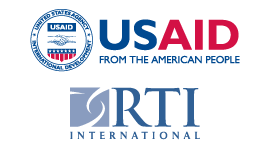
“There are many unknowns, information is not always clear, and students have to put the pieces together to solve the mystery – meaning, make a decision,” she said. “And it requires multiple drafts. You never get it right the first time.”
The three-day workshop is part of the Science, Technology, Research and Innovation for Development – or, STRIDE – initiative, a five-year, multimillion-dollar effort funded by the United States Agency for International Development (USAID) in partnership with RTI International. Its goal is to foster economic growth and development in the Philippines through support of education, research and industry partnerships in high-growth economic fields, including science and technology.
This is the third case writing workshop WDI has organized and delivered, and the first one led by Felker, a WDI case writing consultant and former associate dean at the University of Michigan-Dearborn College of Business.
Thirty-five professors from a variety of disciplines will attend the April 6-8 workshop in Iloilo City, a member city of the USAID Philippines’ Cities Development Initiative (CDI). The two previous workshops were held in the capital city of Manila; the new location better incorporates the experience and input of professors at universities outside of Manila, organizers said.
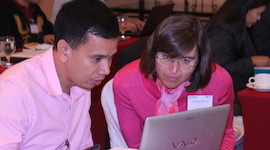
WDI case writing consultant Andrea Meyer, right, helps a professor with his business case at an April 2015 workshop in Manila.
Each of the faculty members will arrive at the workshop with an idea for a case study that examines companies or organizations in the Philippines. Over the three days, Felker and WDI case writing consultant Andrea Meyer will help the professors begin writing an effective case study. After the workshop, the professors will get editorial guidance from the WDI Publishing staff.
Completed cases will be featured on the Philippines Case Collection hosted by WDI Publishing and available for free to faculty in the Philippines and other universities around the world. To date, 41 cases and mini-cases written by previous workshop participants are available.
The cases are some of the first to be written by Filipino professors about domestic companies, and discuss the challenges and successes of companies and organizations in a variety of fields – including health care, software, ecotourism, microfinance, marketing and many others. The cases will help prepare students for careers in these high-growth sectors by exposing them to real-life challenges and dilemmas of Filipino companies, and encouraging them to use creative problem-solving skills.
On the workshop’s first day, Felker will discuss situating cases and the case teaching method into the broader curriculum. She will talk with the participants about learning goals, the case writing process, case topics, how to approach and work with organizations, conducting research and doing interviews.
On the second day, participants will go through components of a case, including protagonist, introduction, organizational background, industry/competitive overview, problems and challenges. Participants will then work individually on each section, share their ideas in small groups, then the class will get back together to discuss. Felker and Meyer will provide advice and feedback individually and to the class as a whole.
On the final day, participants will have some time to work on different case components, do some writing and conduct research. Felker also will talk about teaching using the case method. And plans are being made for previous workshop participants to speak to the current cohort about their case writing experience.
“The writing process in many ways is unique to each individual – where they write, how much they write at any given time, how they organize their ideas,” Felker said. “However, case writing is quite systematic and requires a plan of action.”
Like that detective novel, Felker said writing a case study is about telling a story – but with a common structure. A writer must know his or her audience – in this case, students – and what knowledge skills and abilities they have.
“At the core of case writing are learning objectives,” she said. “Before they start writing, case writers must articulate the desired learning outcomes students should acquire through analysis of the case. For example, what should students know, what should they be able to do, and what should they be thinking about?”
Felker said she is excited to be a part of the STRIDE project and the case writing portion of it. Daniel DeValve, project administrator for WDI’s Development Consulting Services, which oversees the institute’s work on the project, said the workshop is popular with faculty in the Philippines. More than 80 applied for this workshop.
“The STRIDE case study workshop has proven successful in motivating university professors from a variety of disciplines to incorporate real-life examples into their classrooms, which, in turn, serves to better prepare students for employment fields such as management, business and technology,” DeValve said. “Professors have reported that the process has improved both their writing and teaching styles, and many have expressed strong interest in publishing additional case studies in the future.”
Kerry Shields worked in the healthcare industry before coming to U-M’s Ross School of Business for her MBA and has plans to return to it after graduation. So she was eager to find a MAP (Multidisciplinary Action Project) in a different industry, and was ecstatic when she learned she was part of the WDI-sponsored MBA student team working with the Relationship Coffee Institute and Sustainable Harvest in Rwanda.
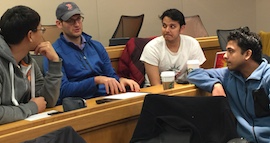
The Relationship Coffee Institute (RCI) is a nonprofit, public benefit corporation – or, B Corp – working to increase social and economic opportunity for smallholder commodity farmers and their families. Its partner, Sustainable Harvest, is one of the largest importers of fair trade specialty coffee in the U.S.
“What this company is trying to do is important and innovative and I can learn from that,” she said. “Hopefully we will have had an impact at the end of the project and get a better understanding how a private company can help alleviate poverty.”
The MAP in Rwanda is one of eight student projects organized and sponsored by WDI. MAP is an action-based learning course offered at Ross for MBA students who receive guidance from their faculty advisors. Each project requires analytical rigor, critical thinking, and teamwork. Sponsors receive top-notch deliverables and data-driven recommendations from the team of students.
After learning about their projects and conducting research in the classroom for several weeks, the students then spend three to four weeks working alongside their project sponsors in the field.
Sylvia Jimenez will work on a WDI-sponsored MAP team for CARE, a non-profit organization seeking to use business approaches to address social issues.
“I’m looking forward to getting out of my comfort zone and doing something different than I have done before,” she said. “I think I’ll learn a lot about me as a team player, and learn about my teammates and what their strengths are.”
Ted London, vice president of WDI’s Scaling Impact Initiative, is one of the faculty advisors on the Sustainable Harvest and CARE MAPs as well as two others. Before the teams traveled to their destinations for on-the-ground work, he brought them together for a special WDI-focused session to get to know each other better before they left and to touch on some of the key issues the teams will face in the field.
He discussed what it takes to conduct good interviews, particularly in a base of the pyramid (BoP) market context, emphasizing that the goal of these interviews is to develop data-driven recommendations. Among other things, he also told the students to approach people they meet and interview with respect and humility to maximize the depth and quality of the data collected during the interview.
“You are not only there as expert problem-solvers, but also as experts in learning and listening,” he said. “Only by collaborating and co-creating can we build solutions that really work.”
London said his MAP projects allow students to take what they learned in the classroom and apply it in a BoP context.
“For students interested in working in this space as a career, it is an amazing opportunity,” he said. “These MAPs open students’ eyes to this part of the world and to this scale of enterprise and impact. They’re part of the minority seeing how the majority of the world conducts business.”
WDI and its partners get value from the experience as well, London said. Seven of the eight MAP projects are with partners that have long-term relationships with WDI.
“By leveraging MAP and the great skills of the Ross students, we’re providing resources and expertise to our partners to help them solve the problems they’re facing,” London said. “And it’s a way for us to collaborate with partners in the field, apply our knowledge, and learn what are the next-generation tools we need to think about in the future.”
Here is a summary of each MAP project:
Aravind Eye Care System – India
Advised By: Paul Clyde, WDI and Ross School of Business; Peter Lenk, Ross School of Business
MAP Team: Jackie Barnum, Katie Redman, Alex Kravitz, Matt Tafoya
Aravind Eye Care System (AECS) has five tertiary care centers, six secondary care centers, six community clinics, and 54 primary eye care centers across the Tamil Nadu state in India. Now AECS is expanding, opening tertiary hospitals in Chennai and Tirupathi in the next couple of years, and there are also plans to expand the services/facilities in the existing hospital units.
The student team will customize and test at two to three AECS facilities an existing process model that will measure performance of each unit and is understandable to everyone in the organization.
Cooperative for Assistance and Relief Everywhere (CARE) – India
Advised By: Ted London, WDI and Ross School of Business; Jane Dutton, Ross School of Business
MAP Team: Karina Cabanillas, David Chang, Takashi Takizawa, Sylvia Jimenez
CARE has been working in India for over 65 years, focusing on ending poverty and social injustice. Its overall goal is the empowerment of women and girls from poor and marginalized communities leading to improvement in their lives and livelihoods.
Most smallholder farmers, a vast majority of whom are women, have limited access to quality and affordable agriculture input, services, finance and technologies. The student team will develop a profitable and socially inclusive business plan that CARE can execute in 2016 that facilitates access for smallholder farmers to inputs and related services. This should be a commercially viable and financially sustainable approach that avoids donor dependency through the development of an agricultural input supply social enterprise in India.
Sustainable Harvest & Relationship Coffee Institute – United States
Advised By: Ted London, WDI and Ross School of Business; Ravi Anupindi, WDI and Ross School of Business
MAP Team: Stacey Nathan, Whitney Augustine, Erdem Eray, Grant Cowherd
Sustainable Harvest of Portland, Ore. is an importer of high quality, specialty grade coffees from smallholder farmers from 15 countries around the world. In 2012, Sustainable Harvest formed a nonprofit organization, the Relationship Coffee Institute (RCI), to help propagate its business model and advance farmer training. In fall 2015, in conjunction with RCI and 4,000 women farmers in Rwanda, Sustainable Harvest launched Question Coffee, which represents its fundamental goal to empower coffee farmers and foster sustainable supply chains. It is Sustainable Harvest’s first B Corp certified product throughout the entire value chain, meaning it’s a for-profit entity that includes positive impacts on society, workers, and the environment. Net proceeds from Question Coffee go to farmer training, which contributes to better quality, improved yields and increased income and wellbeing for coffee farmers at the base of the pyramid.
The student team will conduct research to identify Question Coffee’s value proposition to consumers, resulting in several specific, actionable recommendations on branding and marketing strategies. The team also will devise several recommendations and strategies for greater market penetration.
Relationship Coffee Institute (in partnership with Sustainable Harvest) – Rwanda
Advised By: Ted London, WDI and the Ross School of Business; Jane Dutton, Ross School of Business
MAP Team: Courtney Landy, Aaron Whallon, Juan Marino, Kerry Shields
For this project, the student team will test and evaluate the value of B Corp certification to see if it could improve the lives of smallholder farmers in Rwanda, and how it could be scaled or applied to other commodities.
Zemen Bank – Ethiopia
Advised By: Paul Clyde, WDI and Ross School of Business; Bob Dittmar, Ross School of Business
MAP Team: Dana Yerace, Max Jacobson, Florence Noel, Nicholas Mencher
Zemen is a commercial bank located in Addis Ababa, Ethiopia. Its vision is to bring new dynamism to the financial sector and the banking business in Ethiopia. It is interested in serving small- and medium-sized enterprises (SMEs). Using a banking scheme in which Ethiopians living in the U.S. could put a hold on some monetary amount in their bank account, Zemen would then access the account for a low interest loan for Ethiopian citizens starting or expanding a small business. The hold on the U.S. bank would be reduced as the loan is paid back.
The student team will develop the business case for diaspora SME loans and assess the prospects for scaling the program to a level that would interest Zemen Bank. If the scheme were deemed viable, then the team would formulate a plan for executing the program.
Imperial Health Sciences (IHS) – South Africa
Advised By: Paul Clyde, WDI and Ross School of Business; Ravi Anupindi, WDI and Ross School of Business
MAP Team: Amit Patel, Jennifer Paxton, Anuja Mehta, Aric Adams
IHS provides supply chain solutions to the public and private pharmaceutical markets in Africa. IHS and the Imperial Logistics group have adopted the Unjani project as its Corporate Social Responsibility project. Unjani aims to establish a network of nurse-owned franchise clinics in historically underserved communities across South Africa. It has 19 operating clinics with plans to add 25 more by May. The group will take over an independent, failing clinic.
The student team will assess the change in the failing clinic’s success level after instituting the processes, controls, training, and marketing of the Unjani franchise network. Examining the operational and environmental factors of the clinic, along with some financial analysis, will allow IHS to better understand why this clinic failed. That will help IHS further develop the Unjani concept and ensure successful clinics in the future.
ITC Ltd. – India
Advised By: Ted London, WDI and Ross School of Business; Venkatram Ramaswany, Ross School of Business
MAP Team: Nishant Agrawal, Kee Cho, Arun Prakash, Dave Teebagy
ITC is a major diversified Indian conglomerate. ITC’s e-Choupal initiative is enabling Indian agriculture to enhance its competitiveness by empowering Indian farmers through the power of the Internet. The initiative facilitates the two-way flow of goods and services in and out of villages, and describes itself as the largest Internet-based intervention in rural India by a corporate entity.
The student team will help ITC design the next version of e-Choupal. The team will deliver a report exploring how the first three versions of e-Choupal have created value and where further opportunities for value creation may exist. The team also will look into how other models of rural farmer engagement are being deployed in other developing countries, identify the various stakeholders impacted, and highlight how the proposed model creates value for them.
Aparajitha Foundation – India
Advised By: Paul Clyde, WDI and Ross School of Business; Jim Walsh, Ross School of Business
MAP Team: Jamyle Michael, Holly Price, Aaron Steiner, Meghan Sheehan
The Aparajitha Foundation is an arm of the Aparajitha Group. It is committed to the cause of creating transformational change in adolescents by using audiovisual technology to deliver life skills training to economically disadvantaged children in India’s Tamil Nadu state.
The MAP team will develop a complete business plan for entrepreneurship education, training and development. The model should be scalable so that it can be used across the country in the future.
“Hack-a-thons” are best known as weekend-long events where software developers and computer programmers – fueled by pizza and caffeine – team up to create a new software app or build a new tech gadget. These marathon sessions are less commonly associated with tackling global health challenges.

But the same spirit of energy, collaboration, and dedication used to develop new technology could similarly apply to preventing the spread of disease, says WDI’s Beatrix Balogh, who along with three colleagues, plans to host such an event in Ann Arbor in June.
Health-themed hack-a-thons are growing in popularity as those in the field explore new ways to innovate and create new technologies and processes. In February, Balogh participated in a Boston hack, where she and her team worked on a training/business model around self-screening for breast cancer in rural areas of Africa. She also spent time taking notes in preparation for the Ann Arbor event.
“We were able to talk to the organizers about things that worked well, things they struggled with,” said Balogh, research associate in the market dynamics group of WDI’s Healthcare Research Initiative. “They had a lot of good insights.”
About a year ago, shortly before Balogh and Brittany Johnson, a global health supply chain consultant, attended a hack-a-thon in Cleveland, they began kicking around the idea of bringing a health-themed hack to Ann Arbor. They reached out to Neelima Ramaraju, director of global health initiatives at Ann Arbor’s LLamasoft, a supply chain design firm, to gauge her interest.
“Between the resources, talent, and enthusiasm we have in this community, it seemed like a no-brainer,” Ramaraju said. “So far the community has been very receptive and supportive, validating our reasons for getting started.”
Ramaraju brought in friend Diane Bouis, director of innovation programs at The Inovo Group, a strategic innovation consultancy in Ann Arbor.
Together, the four women formed the nonprofit Ann Arbor Health Hack (A2H2 for short) and started making plans for a hack-a-thon in Ann Arbor this summer. They have weekly planning meetings, have created a Facebook page, and a website will be online soon. Upcoming informational mixers are set for March 9 and 29 in Ann Arbor. Check the hack-a-thon Facebook page for details.
The event, A2H2 Weekend: Prototyping Disease Prevention, will be held June 24-26 at Palmer Commons on the U-M campus. The organizers are hoping to attract 200-250 students, researchers, and professionals from the biomedical, engineering, IT, design, and public health sectors.
It will focus on disease prevention in developing countries as well as underserved areas of developed countries. Prevention includes creating information tools, enhancing education of patients and caretakers, policy and social engineering. It also includes products and services such as personal and surgical hygiene, family planning, wellness care, diagnostics, vaccines, and medication adherence.
A networking event Friday evening will kick off the weekend, with the hack-a-thon starting Saturday morning. Participants will work through the night till noon Sunday, and present their projects to a panel of judges. The winners receive prize money and potentially a space to incubate their idea along with some seed funding. Sponsors of the hack-a-thon include WDI, The Inovo Group, LLamasoft, Ann Arbor SPARK, MakeHealth Fest, and Gamestart.
Ramaraju said events like hack-a-thons make the global healthcare space more accessible.
“As a complex and highly-regulated field, the healthcare market requires deep domain knowledge to bring about change, making it difficult for a lay coder or maker to have a significant impact on their own,” she said. “A hack-a-thon will bring together the medical, academic, entrepreneurial, and industry minds to generate novel ideas, and hopefully new products that lead to healthier lives worldwide.”
Organizers, who plan to make this an annual event, ask attendees to come with ideas, but not necessarily with a set team. They are hoping at the pre-hack mixer on Friday night as people discuss their ideas, participants will start to gravitate towards projects that appeal to them.
Hack-a-thons are most successful when diverse teams form at the start of the event, Bouis said.
“Bringing together a diverse team of people from different areas can help find solutions that somebody who is a deep specialist would have never found by themselves,” she said. “You cannot do something radically new if you think along the same pathways with the same people you have already thought with and worked with in the past. Mix it up.”
Ramaraju said a hack-a-thon “can energize the community, make people aware of the existing resources, and create collaboration opportunities that wouldn’t have otherwise existed.”
The event, Bouis said, enables people to do great things. It is a conduit for bringing the right people together.
“If something that changes the face of healthcare comes out of the hack-a-thon, that will be immensely gratifying,” Bouis said. “Can I guarantee that there will be any to change the face of healthcare? No, I can’t promise. Is it possible? Yes, and that’s exciting.”
Image courtesy of Global Cancer Innovation Hack-a-thon.
Ray Cummings, director of market dynamics for the global nonprofit health organization PATH, recently sat down for a one-on-one video interview with WDI’s Andrea Bare to discuss how it works to improve global health outcomes. The two also talked about Cummings’ career and how U-M students interested in the healthcare field can get involved in global health.
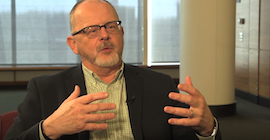
Cummings also spoke to U-M students for the WDI Global Impact Speaker Series on Feb. 17 about how PATH is addressing the challenge of improving coverage rates for many childhood vaccines in low-income countries.
“Ray has deep expertise in healthcare technology development and commercialization in both developed and emerging economies,” said Bare, senior advisor in the WDI Healthcare Initiative’s Market Dynamics group. “He works from the vantage point of several years in biopharmaceuticals business development and partnering, and has brought that expertise to PATH where he has led or contributed to projects for drugs, vaccines, and diagnostics in diseases such as malaria, HIV, and Japanese Encephalitis.”
Cummings’ market dynamics department provides analytical and strategic support for PATH programs that are working with both non-profit and commercial partners to develop new therapies, vaccines and diagnostics for underserved populations around the world. He also has served as commercialization director for PATH’s drug development global program, and senior business officer in its vaccine and pharmaceutical technologies group.
Cummings is the second Global Impact Speaker from PATH. In 2013, Amie Batson, chief strategy officer of PATH, spoke for the WDI speaker series. View a one-on-one interview with Batson here.
Also, PATH has partnered with WDI on several summer internship projects, including 2011 in Bangladesh, 2012 in India, 2013 in Vietnam and Cambodia, and 2015 in the U.S., South Africa, Ghana, and Uganda.
WDI and PATH are currently discussing the scope of a 2016 summer internship with the organization.
Prior to joining PATH in 2009, Cummings held senior business development positions at AVI BioPharma, Inc. (now Sarepta Therapeutics), GD Searle & Co., and Immunex Corp. (now part of Amgen Inc.).
Cummings has a bachelor’s degree in biological sciences from Stanford University, a master’s degree in biochemistry and molecular biology from Harvard University, and an MBA from the University of California, Berkeley.
Vaccines save 2.5 millions lives annually according to the World Health Organization, and during the past 15 years major strides have been made in coverage rates for many childhood vaccines in low-income countries.
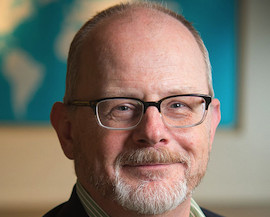
However, challenges remain as evidenced by the 1.5 million children under the age of 5 who still die each year from vaccine-preventable illnesses. Reducing this number will require progress on a range of economic issues related to vaccine procurement funding, reductions in vaccine costs, and economic sustainability of existing vaccine products.
Ray Cummings, director of market dynamics for PATH, will discuss how the Seattle-based international, nonprofit health organization is addressing these challenges as part of the WDI Global Impact Speaker Series.
Cummings’ Feb. 17 talk, “Economics of Global Vaccine Markets and Current Challenges,” will begin at 5 p.m. in Room R2220 at the Ross School of Business. It is free and open to the public.
“Ray has deep expertise in healthcare technology development and commercialization in both developed and emerging economies,” said Andrea Bare, senior advisor in the WDI Healthcare Initiative’s Market Dynamics group. “He works from the vantage point of several years in biopharmaceuticals business development and partnering, and has brought that expertise to PATH where he has led or contributed to projects for drugs, vaccines, and diagnostics in diseases such as malaria, HIV, and Japanese Encephalitis.”
Cummings’ market dynamics department provides analytical and strategic support for PATH programs that are working with both non-profit and commercial partners to develop new therapies, vaccines and diagnostics for underserved populations around the world. He also has served as commercialization director for PATH’s drug development global program, and senior business officer in its vaccine and pharmaceutical technologies group.
Cummings is the second Global Impact Speaker from PATH. In 2013, Amie Batson, chief strategy officer of PATH, spoke for the WDI speaker series. View a one-on-one interview with Batson here.
Also, PATH has partnered with WDI on several summer internship projects, including 2011 in Bangladesh, 2012 in India, 2013 in Vietnam and Cambodia, and 2015 in the U.S., South Africa, Ghana, and Uganda.
WDI and PATH are currently discussing the scope of a 2016 summer internship with the organization.
Prior to joining PATH in 2009, Cummings held senior business development positions at AVI BioPharma, Inc. (now Sarepta Therapeutics), GD Searle & Co., and Immunex Corp. (now part of Amgen Inc.).
Cummings has a bachelor’s degree in biological sciences from Stanford University, a master’s degree in biochemistry and molecular biology from Harvard University, and an MBA from the University of California, Berkeley.
Speaker: Douglas Balfour, CEO, Geneva Global.
Geneva Global is a new type of international philanthropy services organization, working in the non-profit, the impact investment and international business arenas in order to see real social transformation focused on the three foundational pillars of education, health and economic empowerment. Doug became the CEO and owner of Geneva Global in September 2008, in a management buy-out after joining the organization in 2006 as its International Director. Prior to joining Geneva Global, Doug was co-founder and Executive Director of Integral – an alliance of 13 Western Relief and Development agencies around the world. He also co-founded the Micah Network – a 400 strong southern NGO network and a global advocacy campaign called The Micah Challenge. Prior to that, he served as General Director of Tearfund, the 6th largest relief and development agency in the UK. During that time he doubled the income and tripled the social impact of the charity. He studied geology at Southampton
University, and his first job after graduating was running diamond exploration programs in Northern Namibia. He has an MBA from Cranfield School of Management.